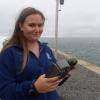Hi all!
I am working on a project studying pinniped habitat use in the Eastern US. We set up camera traps across the haul-out areas, set to take 4 images per hour. If a seal was on a haul out site for an hour, then it would be captured 4 times per hour, likewise if there were 4 seals that were on the haul-out site for 8 hours, then there was a total count of 128 seals. This poses an issue for the presentation of the data for the report as there would be a very large number of total seals counted (e.g. 4 seals X 4 photos X 8 hours = 128). So four seals becomes 128 total counted, which is not representative to the actual number of seals in the area.
We are trying to determine a better way to normalize this data for presentation as we are not sure modeling density or abundance is possible given the cameras are not set up randomly, but are placed according to where the seals haul-out. We have tried dividing the total number of seals counted by the total number of images, but that just results in small decimals which does not show us much.
Does anyone have any advice on how else to normalize the data? We appreciate any input.
2 June 2023 1:42pm
Hi @mguins
This might be a good case for occupancy models. I am not overly familiar with the modelling procedures, but there are some good summaries out there if this is something you haven't already considered, starting with the famous MacKenzie et al. (2002) paper:
16 June 2023 1:06pm
If you can recognise individual seals (or at least whether a new one has arrived, and/or a previous one has left) you might be able to do simple counts for each site. How many sites do you have, for how long were the cameras out there, are there images with no seals between those with seals ?
16 June 2023 5:36pm
Hi Michelle,
it would be good to get some more information on your project. What question are you trying to answer? How many cameras did you have deployed? How many different study sites/haul-out areas are there?
27 June 2023 6:03pm
Also, for more help, here is the link to the website where an old report is shown. Navy Marine Species Monitoring :: Time-lapse Camera Surveys of Pinnipeds in Southeastern Virginia











Rob Appleby
Wild Spy